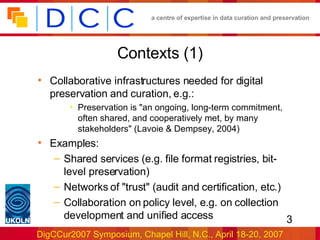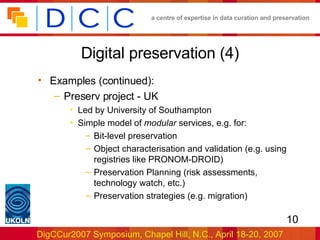Co-operation for digital preservation and curation: collaboration for collection development in institutional repository networks
- 1. Co-operation for digital preservation and curation: collaboration for collection development in institutional repository networks Michael Day , Maureen Pennock and Julie Allinson UKOLN, University of Bath Bath BA2 7AY [email protected]/ http://www.ukoln.ac.uk/
- 2. Presentation outline Emerging work from the Digital Curation Centre Contexts Collaborative infrastructures for digital preservation Networks of institutional repositories Collaboration on preservation infrastructures Collaboration on collection development policies Potential areas for collaboration Conclusions What do digital curators do? What do they need to know?
- 3. Contexts (1) Collaborative infrastructures needed for digital preservation and curation, e.g.: Preservation is "an ongoing, long-term commitment, often shared, and cooperatively met, by many stakeholders" (Lavoie & Dempsey, 2004) Examples: Shared services (e.g. file format registries, bit-level preservation) Networks of "trust" (audit and certification, etc.) Collaboration on policy level, e.g. on collection development and unified access
- 4. Contexts (2) Institutional repositories: Used by higher education and research organisations to provide (open) access to peer-reviewed publications and other research materials Increasingly supported by deposit "mandates" from universities or research funding bodies Setting up a repository implies an institutional commitment to long-term stewardship
- 5. Contexts (3) Collaborative infrastructures for institutional repositories: Distributed services linked (for access) by metadata harvesting OAI-PMH Data Providers vs. Service Providers (aggregators) Potential for the development of shared services to support repositories Alma Swan & Chris Awre, Linking UK Repositories (JISC, 2006): http://www.jisc.ac.uk/
- 6. Contexts (4) Potential shared services (from Swan & Awre): Advisory services (e.g. on IPR, preservation) Content creation, digitisation Repository building or hosting Metadata enhancement Resource discovery Name authorities Citation analysis and research assessment Preservation
- 7. Digital preservation (1) Shared services for preservation: Not all institutions with repositories will be expected to manage long-term preservation challenges: Lack of local expertise and resources Existing availability of third party services in related areas, e.g. data archives, national libraries Preservation is a logical area for collaboration
- 8. Digital preservation (2) Examples: DARE (Digital Academic Repositories) initiative - The Netherlands National Library (KB) has responsibility for all content deposited in participating repositories Repository Bridge project - UK Demonstration of harvesting e-theses (using OAI-PHM and METS) by the National Library of Wales
- 9. Digital preservation (3) Examples (continued): SHERPA DP project - UK Developed disaggregated framework for outsourcing preservation, based on the OAIS model Explored the packaging and transfer of content (using METS)
- 10. Digital preservation (4) Examples (continued): Preserv project - UK Led by University of Southampton Simple model of modular services, e.g. for: Bit-level preservation Object characterisation and validation (e.g. using registries like PRONOM-DROID) Preservation Planning (risk assessments, technology watch, etc.) Preservation strategies (e.g. migration)
- 11. Digital preservation (5) Preserv service provider model (Hichcock, et al ., 2007)
- 12. Collection development (1) Collection development: Set of activities, including: selection, acquisition, deselection, disposal, preservation A traditional focus of library collaboration, e.g. on the development of shared collections Need for institutional repositories to consider own collection development requirements with wider (national or international) contexts
- 13. Collection development (2) Managed collaboration on collection development Potentially reduces unnecessary duplication of effort, but ... But may also support redundancy: Replication of content Application of different preservation strategies Need to investigate role of repositories with regard to more formally published research materials Perhaps e-journals should be the main focus of preservation activities in this domain?
- 14. Collection development (3) Institutional repositories need to define collection development policies with regard to: Institutional requirements Interoperability requirements (e.g. OAI-PMH) Preservation requirements
- 15. Collection development (4) Collection development issues: Content types Peer-reviewed research outputs, scientific datasets, administrative records, ... Will be different preservation priorities Object types (file formats) Policies will have direct influence on risks (and costs) of long-term preservation, e.g.: Accepting any format Only accepting a limited number of format types (e.g. PDF/A, XML); need for conversion and validation tools, or considerable post-processing
- 16. Collection development (5) Potential areas for collaboration (continued): Ingest workflows Checking conformance with submission rules Automated tools for format characterisation and validation, maybe conversion (normalisation) Metadata enhancement, e.g. consistent forms of name Ongoing review (and weeding) of collections Withdrawal of content (contentious issue) Superseded or duplicate material Defining preservation service levels Different policies needed for different types of material
- 17. Conclusions (1) What should curators do? Collaborate with other stakeholders on: Strategic level collaboration (e.g. through organisations like the UK Digital Preservation Coalition) Policy development (e.g. through emerging national frameworks) Research and development Standards development (e.g., OAIS, ISO Records Management Metadata) The development of shared services (e.g. GDFR)
- 18. Conclusions (2) What do curators need to know? Where core services are dependent on other organisations (or services): Need to understand the risks Need to deal with these sensibly (e.g., through contracts, service-level agreements, or by moving the most vital functions in-house) Many remaining open questions: Be aware that there are still many unknown unknowns But it is still important to do something (and to collaborate)


















